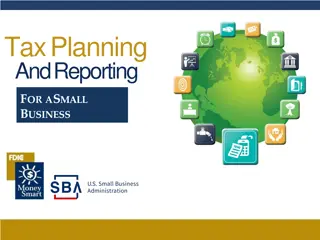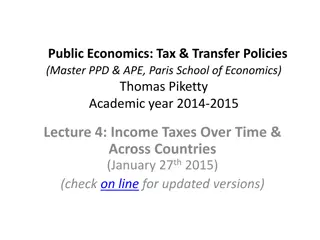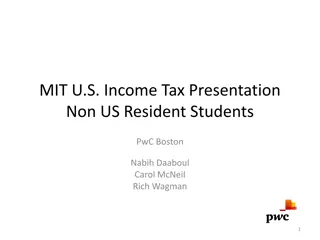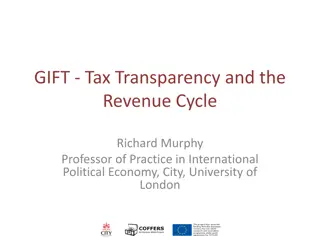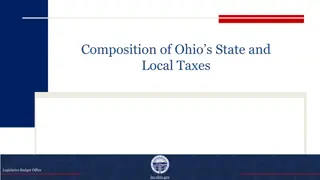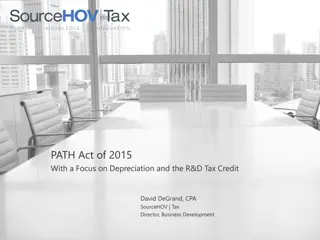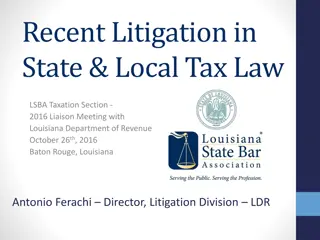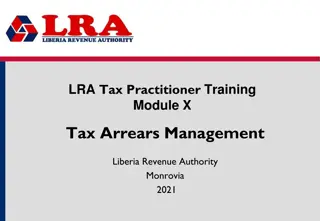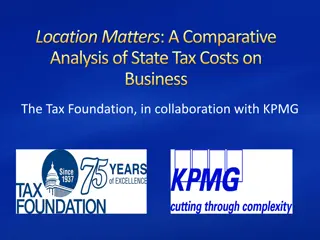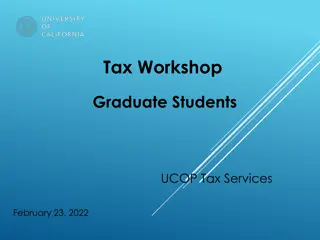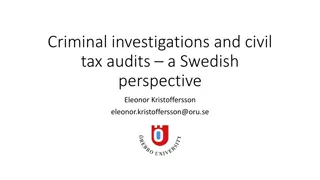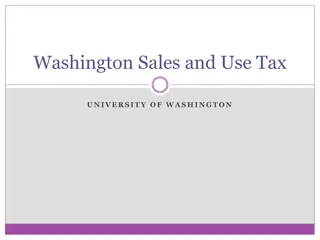
Tax Cuts and Jobs Act Overview
Gain insights into the key elements of the Tax Cuts and Jobs Act of 2017, its implications for state and local governments, and how it impacts corporate tax reform, charitable contributions, and more. Disclaimer: This presentation provides educational information and does not constitute professional advice.
Download Presentation

Please find below an Image/Link to download the presentation.
The content on the website is provided AS IS for your information and personal use only. It may not be sold, licensed, or shared on other websites without obtaining consent from the author. If you encounter any issues during the download, it is possible that the publisher has removed the file from their server.
You are allowed to download the files provided on this website for personal or commercial use, subject to the condition that they are used lawfully. All files are the property of their respective owners.
The content on the website is provided AS IS for your information and personal use only. It may not be sold, licensed, or shared on other websites without obtaining consent from the author.
E N D
Presentation Transcript
THE NEW TAX ACT AND STATE AND LOCAL GOVERNMENTS AGA New Mexico Lealan Miller, CPA, CGFM, Partner 208.383.4756 lmiller@eidebailly.com
AGENDA Key Elements of the Tax Cuts and Jobs Act of 2017 Focus Areas for State and Local Governments Questions This presentation is presented with the understanding that the information contained does not constitute legal, accounting or other professional advice. It is not intended to be responsive to any individual situation or concerns, as the contents of this presentation are intended for general information purposes only. Viewers are urged not to act upon the information contained in this presentation without first consulting competent legal, accounting or other professional advice regarding implications of a particular factual situation. Questions and additional information can be submitted to your Eide Bailly representative, or to the presenter of this session.
DISCLAIMER These materials, and the accompanying oral presentation, are for educational purposes only and are not intended to be written advice concerning one or more Federal tax matters subject to the requirements of section 10.37(a)(2) of Treasury Department Circular 230. This information is of a general nature and based on authorities that are subject to change.
KEY ELEMENTS OF THE TAX CUTS AND JOBS ACT (TCJA) OF 2017.. IN CASE YOU MISSED IT..
TAX CUTS AND JOBS ACT Largest Tax Reform in over 30 Years Corporate Tax Reform Decreased corporate tax rate to 21% Net operating losses can only offset 80% of income Elimination of Corporate AMT Income computed separately for each unrelated trade or business activity Losses of one activity can not be used to offset income of another Can use losses in one year to offset income on same activity in the future Excise tax on executive compensation 20 percent excise tax on any remuneration in excess of $1 million paid to a covered employee Exception for compensation to qualified medical professionals for medical services
TAX CUTS AND JOBS ACT Charitable Contribution Impacts Increase standard deduction Could impact charitable giving Increase percentage limit to 60% of AGI for cash contributions to a public charity Advanced refunding of private activity bonds (and all other municipal bonds) Eliminates exclusion from gross income on interest received on advanced refunding of private activity bond (and all other municipal bonds) More later on this
TAX CUTS AND JOBS ACT- COLLEGES AND UNIVERSITIES Excise tax on net investment income 1.4% excise tax on net investment income of applicable educational institutions Assessed if fair market value of assets (excluding those used directly in carrying out exempt purposes) is at least $500,000 per student May include assets of related organizations Eliminate deduction for college athletic event seating rights Under prior law 80% of the payment was treated as a charitable contribution if Paid to an institution of higher education Amount would have been charitable contribution but for the right to purchase tickets
NEW (2018) INDIVIDUAL RATES: SINGLE FILERS For Governments Make sure right withholding tables being used For individuals Make sure your W-4 is up to date!
FOCUS AREAS FOR STATE AND LOCAL GOVERNMENTS
LOCAL LOBBYING Expenses for lobbying before local government bodies eliminated for amounts paid or incurred after 12/22/17. What does this mean? Could mean fewer visits from business representatives trying for economic development opportunities?
GOVERNMENT CAPITAL CONTRIBUTIONS TAXABLE Tax-free contributions to capital no longer include: A contribution in aid of construction or any other contribution as a customer or potential customer, and A contribution by any governmental entity or civic group (other than a contribution made by a shareholder as such) Contributions made after 12/22/2017 Unclear how this will work with tax abatements, but they may be taxable New York State contemplating converting from tax abatements to grants Could they come back under infrastructure bill??
STATE AND LOCAL TAXES Repeals the itemized deduction for state and local taxes, including income and property taxes, effective after 2017, with the exception of a $10,000 annual allowance. The allowance allows a maximum $10,000 deduction for state and local non-business property and income taxes, or, at the taxpayer s option, property and sales taxes. Same $10,000 limit for joint filers and single taxpayers. What will this mean? Already seeing property tax rates weighing heavily on location decisions, but will states be able to adjust their tax laws to compensate? Also could see a dip in property taxes next year as residents prepaid budgeting could be harder
OTHER ITEMS IN TAX REFORM Teacher expense deduction Unchanged!
ADVANCE REFUNDING OF MUNICIPAL BONDS Eliminates exclusion from gross income on interest received on advanced refunding of private activity bond Private activity bond Bonds in which a government unit serves as a conduit providing financing to a nongovernmental entity Refunding bond Any bond used to pay principal, interest, or redemption price on a prior bond issue Advance refunding bond-proceeds of which are held more than 90 days prior to refunding a prior bond issue Applies for refundings after 12/31/2017
ADVANCE REFUNDING OF MUNICIPAL BONDS 2017 Advanced Refundings was $91 billion 22% of total debt issuances Provide Federal Government approximately $17 billion over the next 10 years
ADVANCE REFUNDING OF MUNICIPAL BONDS What Will This Mean for Governments? Potentially issues with housing finance and volume cap (private activity bonds) Limitations on flexibility if interest rates become more favorable to refund debt Could mean more taxable deals which means Higher interest rates to compensate for tax effect Potentially not a legal defeasance as the escrow may not be essentially risk free (potential loss of principal or substitution risk) Could result in a crossover refunding transaction [two liabilities outstanding at the same time until the crossover date(s)] Talk to your bond counsel / municipal financial advisor prior to contemplating refunding transactions Bill introduced in Congress to reverse these provisions
ADVANCE REFUNDING Options: forward delivery bonds and so-called bond swaptions, to capture the kind of savings that otherwise would have been available through the direct issuance of tax-exempt advance refunding bonds.
OTHER ISSUES Many States (and Local Governments) start with Federal Taxable Income as a base to calculate their tax provisions Could result in governments revisiting their tax codes to break with Federal provisions? Could more states move toward a millionaires tax? Iowa contemplating undoing a reverse tax system Currently allows deduction of federal taxes paid (as federal taxes drop, Iowa taxes go up)
STATE DEPENDENCE ON INCOME TAXES
CURRENT PROJECTIONS As it stands today - it is being estimated that the states will lose revenue from the corporate income tax changes. This is primarily due to full expensing which will result in a timing issue and shift the revenues to a later year. The elimination of the deduction for net interest should offset some of this loss. However, the individual income tax (voters?) will result in a base expansion should result in a large and rapid increase in tax revenue. The federal rate reductions have no impact on the states.
WHAT THE STATES ARE SAYING Minnesota will see a tax windfall of $813 million for 2019 and $1.49 billion in the following two years. Iowa will see additional tax revenue of $106 million in 2019 and $138 million in 2020. Montana is looking at a loss of $67 million to $76 million. Missouri will see a loss of $120 million.
QUESTIONS? This presentation is presented with the understanding that the information contained does not constitute legal, accounting or other professional advice. It is not intended to be responsive to any individual situation or concerns, as the contents of this presentation are intended for general information purposes only. Viewers are urged not to act upon the information contained in this presentation without first consulting competent legal, accounting or other professional advice regarding implications of a particular factual situation. Questions and additional information can be submitted to your Eide Bailly representative, or to the presenter of this session.
THANK YOU Lealan Miller, CPA, CGMA Partner lmiller@eidebailly.com 208.383.4756


![Town of [Town Name] Real Estate Tax Rates and FY 2024 Budget Summary](/thumb/62211/town-of-town-name-real-estate-tax-rates-and-fy-2024-budget-summary.jpg)


